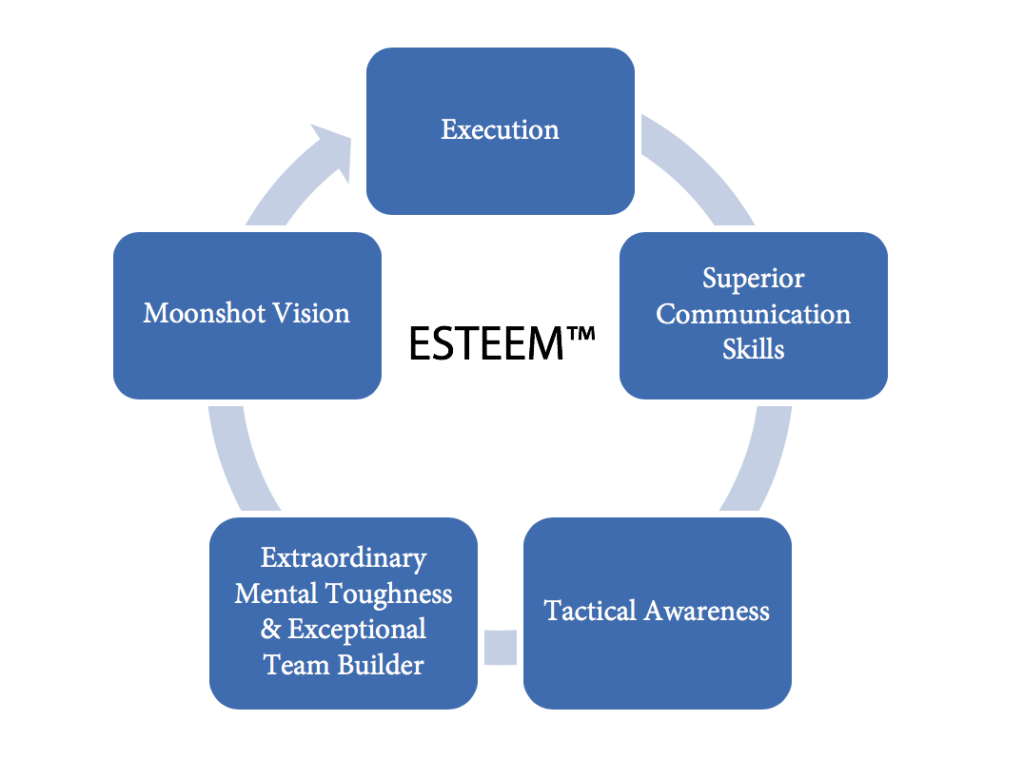Lewis C. Lin wrote a book to help you become the greatest product manager ever

Lewis C. Lin kicked off his career with 15 years in the corporate world as product manager (PM) at Google and Director of Product Management for the search advertising business at Microsoft. Today he runs not one, but two companies. At Impact Interview, Lewis helps aspiring product managers master the PM interview and develop the leadership skills they need to get their dream jobs. His software startup Viamaven allows employees and managers to power through performance reviews much faster.
If you’ve been involved with product management communities, you’re perhaps already a member of the The PM Interview Practice Community. Lewis created the Slack group five years ago, and today it boasts over 13,000 PM professionals.
We were excited to talk with Lewis about his ESTEEM framework for ambitious PMs looking to ascend the product career ladder, how PMs can advance their careers, and what it takes to be the greatest product manager ever.
Continue reading for a lightly edited version of our conversation.
What inspires you to help PMs take the next step in their careers?
It started in 2008 when I had a lot of frustrations when it came to performing well at interviews. I failed at getting more than one dream job so it became a problem that I wanted to solve for myself.
Since then, in addition to helping people land their dream jobs, I’ve been helping PMs move up the career ladder, which is the focus of my latest book, Be the Greatest Product Manager Ever.
A lot of my customers have managed to get jobs as PMs at Google, Facebook, and other highly-desired tech company. Still, they have been struggling to grow in their careers or don’t understand the game plan of how to become a director.
Taking the concerns of my customers and my observations around why some people are more successful in their PM careers, I decided to write this new book.

What is the ESTEEM Method, and how it helps PMs move up the career ladder?
The ESTEEM Method is a framework that distills the six critical skills that you need in order to be the greatest PM ever.
Each one of these competencies roughly maps to different levels within the PM career ladder hierarchy. For instance, the first step, “Execution,” maps to what it takes to be an excellent entry-level PM or individual contributor. Whereas step five, “Exceptional team builder” maps up to somebody senior, like the VP of Product Management or the Chief Product Officer.
Do you mind breaking down what each letter in ESTEEM stands for?
Execution
Superior communication skills
Tactical awareness
Extraordinary mental toughness
Exceptional team builder
Moonshot vision

Execution
Execution means getting things done, and that’s really the whole reason for being a PM. Your boss, your stakeholders, and your customers want a particular product or functionality by a specific deadline. Are you the product leader that can deliver on that?
Superior communication skills
The PMs who just get things done don’t always seem to be the people that get promoted into the next level of authority, which is normally the group product manager role.
The ones who get promoted the fastest to frontline manager responsibilities are the people who have powerful communication skills. These are the PMs who can present in front of executives and customers, or influence the engineering team to adopt a certain product roadmap.
That’s why communication skill is normally one of the earliest indicators of somebody who’s ready to take on additional responsibility at the PM and career hierarchy.
Tactical awareness
Tactical awareness is a concept that stems from the military term “situational awareness”. Whether you’re a soldier on a field, a soccer player, or a product manager, you must be self-aware and aware of the situation around you.
As you exhibit the right judgment and the right decision making, you’d be able to get things done efficiently. Tactical awareness is what helps some managers get consensus on issues in five minutes instead of five months.
Extraordinary mental toughness
Extraordinary mental toughness is required for all PMs that operate at the VP of product management level and beyond.
Think about the person who was responsible for building out two-day shipping for Amazon Prime. While the CEO makes the idea sound simple, it requires billions of dollars and strategic purchase of distribution centers across the United States. Or the SpaceX team that was tasked with sending a rocket to Mars. Or the team that invented the self-driving car.
All we know is that it was extraordinary PMs that were able to execute on these crazy ideas and lead groundbreaking change within their organization.
Exceptional team builder
An exceptional team builder is someone that can build a strong product organization. A capable PM executive can build a top team organization quickly by tapping into their expansive Rolodex.
Exceptional team builders also know that they have a responsibility to level off the skillset of the whole product team. Enlightened executives take it upon themselves to build up their team, even when that involves telling team members how to use a story or manage their backlog.
Moonshot vision
Moonshot vision is all about having some big, hairy, audacious goal. Something that seems so audacious and impossible that it feels like JFK’s 1962 proclamation to send a person to the Moon. A vision so big that it creates a revolutionary move for the company, a move that opens up a new market, category, or platform.
Apart from having an exceptional vision, you need a credible customer need. One of my recent favorites is Whitney Wolfe Herd, the founder of Bumble. Herd’s vision solved the age-old issue of men having control in dating apps. By flipping the script and giving control to women, Bumble takes away some of the friction in dating.
The last piece of the moonshot vision is feasibility. The best leaders willingly get into the details of feasibility, as anything done well requires a very detailed eye. As a way to counter the naysayers, these exceptional team leaders will sometimes get in the weeds to help convince naysayers that an idea is indeed a possibility.
What are the typical job levels for product managers?
The first level that I normally see is that of the individual contributor level. This level could include both more junior roles like Associate Product Manager, as well as more senior roles like Product Manager or Senior Product Manager.
The next level is the frontline manager. It’s usually a Group Product Manager or Head of Product Management. Sometimes I see job titles like Senior Product Manager that have management responsibilities. Also, at smaller companies, the Director of Product Management title could be used to designate somebody who has the frontline responsibility of managing a small team of one to three product managers.
The third level that I see is a manager of managers. That means there are two layers between where you sit as a manager and the people on the front lines. This could be a Director of Product Management with one or two Group Product Managers and frontline product managers underneath that Group Product Manager.
The next level is the VP of Product Management or sometimes, the Chief Product Officer. Those people usually are responsible for the entire PM organization at a company.
And then, of course, the last layer is being CEO, which can encompass additional responsibilities beyond the product function. But at least in my book, my obsession is really around the CEOs that have a strong product focus like Steve Jobs, Elon Musk, Jeff Bezos, etc.
How can PMs influence others and build more power within the organization?
Learning how to influence others usually comes down to how you communicate.
One of my favorite communication patterns is one popularized by management consultants called S. C. R., which stands for Situation Complication Resolution.
It consists of three steps. First, lay out the situation to the people you want to convince through facts and objective figures. Present the urgency and why you need to do something different. Then, use storytelling to explain the dilemma. And of course, propose a solution to the complication.
For example:
The world is a happy place and Superman is traveling the world, but then a complication appears as an asteroid is spinning towards Earth at a very fast rate. Superman has a choice. Does he save New York City or his girlfriend Lois Lane from Lex Luthor? Having that dilemma and that narrative tension is helpful for us as human beings that love a good story. Then you need to finish off with a resolution, because you can’t just leave people hanging. You have to propose a solution for how you resolve that tension.
When starting a new role, you recommend “pausing your ambition for the first 90 days”. What do you mean by that?
When joining a new organization, new PM hires tend to reject or challenge the current way of doing things. This is especially common among MBAs and recent graduates that try to force what they’ve learned in school.
It’s too easy for new hires to play armchair MBA and ponder in a theoretical world. The truth is that the internal team probably knows better, and there might be real reasons why the theoretical approach could not work.
It’s better to integrate into a team and not make enemies from day one or the first 90 days. My suggestion is to pause your ambitions in terms of where you want to be in your career.
Instead, collect observations about the product, about the internal processes, and the people. After you’ve come to the end of those 90 days, you’ll have a more well-informed opinion as to what can be fixed and what can’t be fixed.
—
Curious to learn more about Lewis C. Lin and his new book, Be the Greatest Product Manager Ever? Check out his website here.





![The CPO’s Blueprint for Annual Planning: An Opportunity to Drive Change [Part 3]](https://www.productboard.com/wp-content/uploads/2024/11/strategy-blueprint-560x293.png)
